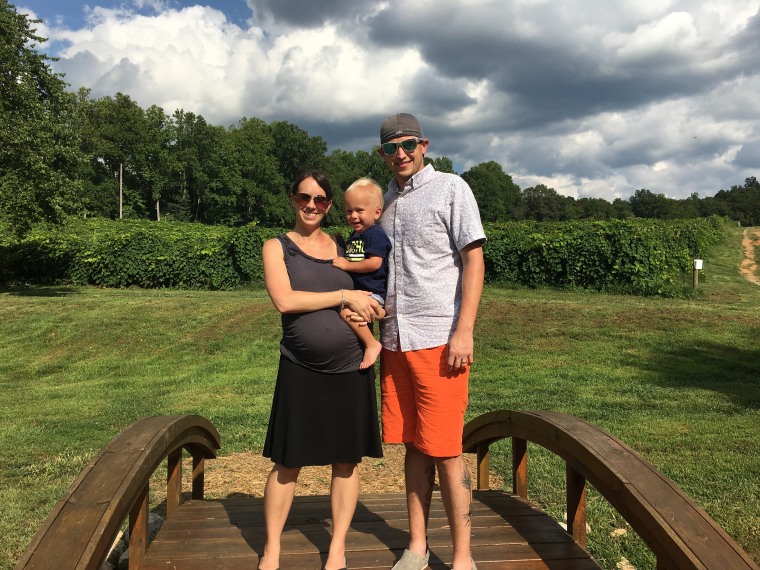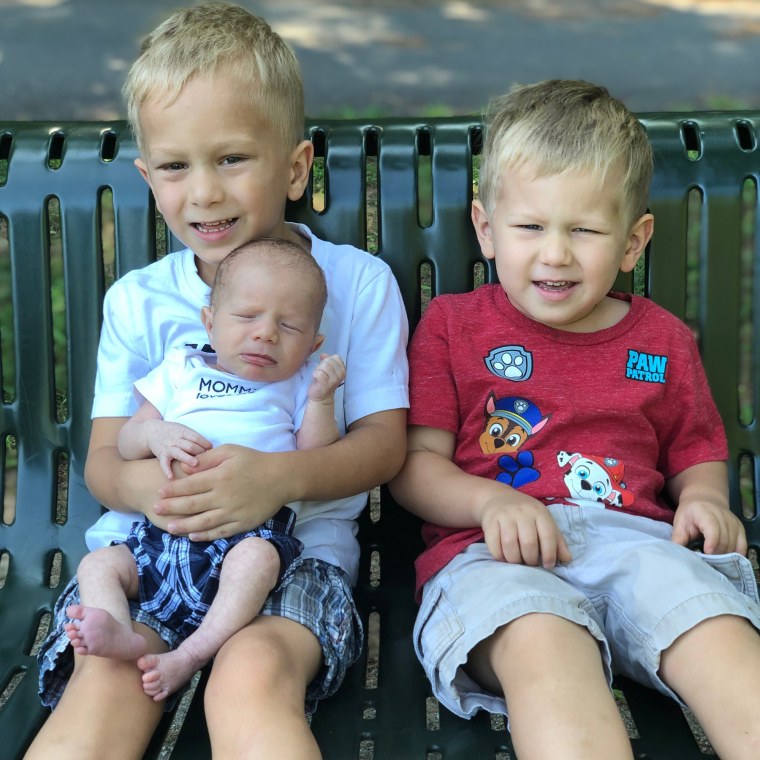In January, Angie and Aaron Rush took their son, Carter, for an eye exam and heard a diagnosis they'd hoped they'd never encounter again — retinoblastoma. The 6-month-old had the same eye cancer that both his brothers had as infants. It was an unbelievable heartbreaker.
“Carter had been clear for six months, we thought maybe we were going to dodge the bullet,” Aaron Rush, 40, of Marietta, Georgia, told TODAY. “We thought maybe he was going to be the 50 percent that didn’t have it.”

But doctors found the now 7 month old has a tumor in each eye, just like his brothers.
“Your first emotion is disbelief and sadness,” Rush said. “Three boys all with the same cancer, it almost all becomes unbelievable.”
While the family always knew that there was a chance that their children could develop retinoblastoma because Angie had it as a child and lost an eye to it, they were still upset.
“It's a fairly rare pediatric cancer,” Dr. Thomas Olson, pediatric hematologist and oncologist at the Aflac Cancer Center at Children’s Healthcare of Atlanta, told TODAY. “You would not expect three children in a row (to have it), but it can happen.”

Retinoblastoma makes up about 4% of cancers in children under 15, according to the National Institutes of Health. There are two types of retinoblastoma, sporadic and inherited. The Rushes knew that Angie’s cancer was genetic, so their children would have a 50-50 chance of developing it. But they always wanted children and gave starting a family a lot of thought.
“We talked about it, all the things that we could do, what would be best for us,” Rush said.
When Tristen was born almost six years ago, he was six weeks early and weighed less than 4 pounds. He spent several weeks in the neonatal intensive care unit and, when he was three weeks old, doctors discovered he had a retinoblastoma tumor in each eye.
“I remember the day exactly when he was diagnosed,” Rush said. “It's a matter of ‘OK, we got to go into attack mode, what does this mean, what we need to do, what is going take place.’”

They treated him with chemotherapy and used lasers to remove the tumors from his eye, while preserving his vision. He developed a few more tumors before he was a year old, which doctors successfully treated. Since his first birthday, Tristen, now 5, has been tumor free.
A year later, Angie became pregnant again and delivered the couple's second child, Caison, four weeks early. When he was two days old, doctors tested his eyes and saw he had a tumor in each.
“We wanted more children and felt like, even with the risk, it was a risk that we were definitely willing to take,” Rush said. “He could've been born without it. I mean it is a coin flip.”
Caison, now 3, also received chemotherapy and laser treatments to remove the tumors from his eye. Even though they had experience with the process with Tristen, the Rushes still struggled.
“You know what's going to happen and all that emotion just kind of floods in,” Rush said.
Caison has also been cancer-free since about his first birthday.
Their third son Carter's birth last year was different. He was only two weeks early and showed no sign of tumors at first. But in January 2020, doctors found he had them, too.
“You go through the guilt and the grief again because now you have three boys who all have the same cancer,” Rush said.

Before they had children, the Rushes knew to have their sons examined for retinoblastoma because Angie had it. But for parents who don't have any experience with the disease, there are symptoms parents can look for that could indicate whether the child has retinoblastoma. Signs include:
- Lazy eye
- Pupil looks white or pink instead of looking red in pictures or when light is shined in
- Redness or bleeding in the eye
- Vision problems
- Eye pain
- Bulging eye
- Pupil that always remains larger
- Different-colored irises
Although grappling with the same cancer diagnosis in all three of their sons has been difficult for the Rushes, they said their faith, friends and family helped them through. Rush also credits his wife's strength.
“You just need to continue to fight,” he said.
The Rushes are telling their story in hopes it will help raise more resources for child cancer research. Only about 4% of the billions spent on cancer research goes to childhood cancers, according to the National Pediatric Cancer Foundation.
Though there is more work to be done, research and treatment has come a long way since Angie, 38, had retinoblastoma and lost an eye as a child.
“It is happening less and less commonly that children are losing eyes because the treatment has improved,” he said. “Most of the treatments that we use are not very experimental.”
Rush wants people to see the optimism in their story.
“There is hope in God’s love and there are people out there that, despite tragic things that happen, they are pressing on and trying to help other people,” he said.